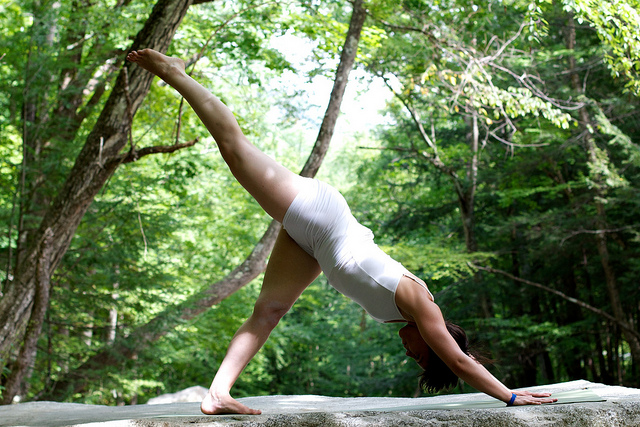Yin Yoga is beneficial for everyone and can enhance all other forms of yoga practices.
Yin yoga nourishes an individual on all levels-–physically, energetically, mentally and spiritually.
Physically, the practice of yin yoga nourishes the body through its focus on lengthening the connective tissues which ultimately helps to increase the range of motion.
Energetically, it nourishes the body by providing it with vital chi (life force energy) which removes blockages and opens up pathways and meridians. The healing chi is delivered to specific areas of the body when postures are held for long periods of time.
Mentally, we feel nourished because the practice gives us the opportunity to go inward to find stillness and time for contemplation.
Spiritually, it nourishes us by developing the capacity to endure long holds and being able to surrender to the present moment and accept the dualities as they come up in each pose (such as ease, resistance, discomfort and comfort, hard and easy).
With all these benefits, one could say that the practice of yin yoga helps to bring awareness and relieve suffering that one experiences physically, mentally, emotionally and spiritually.
Personally I see yin yoga as a process of settling in and finding the asana (seat). The practice encourages me to be gentle like a flower, stable like a tree and expansive like space.
The flower analogy of Yin Yoga:
To be gentle like a flower, means to practice with compassion, kindness and understanding.
When I practice this way, I allow in well-being. As a result my interactions with others also carry the energy of well-being. Just as a flower spreads its fragrance freely, when we practice yin yoga we become like the flower spreading kindness, compassion and understanding to all that we come in contact with.
The tree analogy of Yin Yoga:
To be stable like a tree means that once I have found my seat I stay there and connect to my roots.
I observe my physical, emotional and mental being without attachments or aversions.
The space analogy of Yin Yoga:
To become expansive like space means to accept what is feeling freedom and expansiveness within my body and mind.
When there is freedom in the mind and body then there is capacity for space which allows one to handle life with an attitude of inclusivity.
Four reasons to practice Yin Yoga:
Physically the practice of yin yoga nourishes the body through its focus on lengthening of the connective tissues. Connective tissue refers to the ligaments and fascia. These are yin areas within the body which are deep. These tissues bind bone to bone. Because the practice of yin yoga pulls on the connective tissues it aids the body in feeling freedom and lightness. It also aids the body in developing flexibility of the joints.
It is important to stretch our connective tissues because if we do not stretch them, they will gradually shorten which creates physical limitations and restricts the body’s natural range of motion. If we want to feel physical flexibility and ease, practicing yin yoga is essential.
Energetically, the practice of yin yoga enhances the quality of our chi or prana flow.
This is done through holding various poses for longer durations in stillness and setting an intention. An intention could be to invite chi flow into areas where it is deficient or areas where there is stagnation. This practice aids one in better absorption and harmonization of chi, thus acting as a preventive for disease.
There are three ways to direct chi flow in a yin yoga practice and the first way is to bring the body into a various yoga postures in a gentle way that pull on the tissues. This action of pulling evokes the body’s natural repair response, thus inviting chi and blood to flood into these areas, making them stronger and better lubricated.
The second way is to mobilize energy is through breath, or pranayama practice. Pranayama helps to harmonize the flow of prana, thus having a direct balancing effect on the body and mind. Pranayama exercises can be performed during a yin yoga practice.
The third way to stimulate chi flow during yin yoga is through the use of the mind. The mind is used to direct prana or chi to the areas where needed. As the saying goes the “energy goes to where our attention flows.” This allows us to use our powerful minds in a more constructive way. It gives us the opportunity to train the mind and become more empowered to heal ourselves from physical and mental aches.
On an emotional level yin yoga can help a practitioner to process emotions in a healthy way rather than acting out of habitual patterns of reaction.
During the practice of yin yoga emotions may come up. By the practice of mindfulness—just witnessing and observing the emotions for what they are, we can release them and become more present.
If we experience anger, with mindful attention we simply say to ourselves “there is anger here.” As we recognise these mental formation we stay in the pose simply breathing and remaining still and alert to our experience without reaction and judgement. Practicing in this way creates a safe environment and a sense of equanimity—the practitioner is given an opportunity to harmonize disturbing emotions.
Spiritually yin yoga connects us from gross levels of our existence to the subtle and beyond. During a practice we have some time to connect with ourselves physically, emotionally, energetically and spiritually. We get the opportunity to look deep within and to observe without judgement all the facets of being.
Thus, our spirit or higher consciousness becomes more open to all experiences within and outside of us, connecting us to the Oneness or bliss.
As we practice a yin pose we learn to be inclusive off all that is happening in the moment (whether the experience is comfortable or uncomfortable) and during the same time we can practice impermanence—not clinging to the pleasure or having aversion to the unpleasant experience.
Spiritually this practice develops insight and wisdom in a practitioner over time. Yin yoga also helps to create stillness and space thus preparing one for the practice of mediation.
Love elephant and want to go steady?
Sign up for our (curated) daily and weekly newsletters!
Editor: Catherine Monkman
Photo: Matthew Ragan/Flickr











Read 1 comment and reply